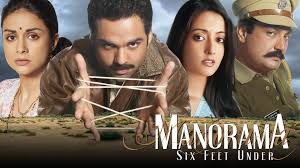Explore 13 Indian films that have perfected the Neo-Noir style, blending grit and glamour with dark, atmospheric narratives. A deep dive into the genre’s evolution.
The Indian film industry, known for its vibrant musicals and sweeping love stories, has also dabbled in darker, more nuanced genres. One of the most fascinating developments in Indian cinema in recent years has been the rise of Neo-Noir, a genre that combines the gritty, atmospheric qualities of traditional noir with a more contemporary sensibility. With its themes of moral ambiguity, flawed protagonists, and urban decay, Neo-Noir offers a fresh lens through which to explore the complexities of modern India.
In this article, we will delve into 13 Indian films that have successfully embraced the Neo-Noir style, transitioning from the raw grittiness of their narratives to a sense of glamour through visual aesthetics, complex characters, and intricate plots.
What is Neo-Noir?
Before we dive into the films, it’s essential to understand the Neo-Noir genre. Originating in the 1940s and 1950s, classic Film Noir was characterized by its dark, shadowy cinematography, morally ambiguous characters, and cynical worldviews. Neo-Noir, as the name suggests, is a modern adaptation of this style, often incorporating new storytelling techniques, more sophisticated cinematography, and addressing contemporary issues.

Indian Neo-Noir films tend to explore urban themes, complex social dynamics, and psychological depth. These films are marked by moody visuals, intricate plot twists, and a tendency to blur the lines between good and evil.
1. Kahaani (2012): The Femme Fatale Reimagined
One of the most iconic Indian Neo-Noir films is Kahaani, directed by Sujoy Ghosh. The film features Vidya Balan as Vidya Bagchi, a pregnant woman searching for her missing husband in Kolkata. The film plays with the traditional elements of Film Noir, including an unreliable protagonist and a labyrinthine plot. Its atmospheric cinematography, especially the moody Kolkata streets, and Balan’s nuanced performance, bring a fresh take on the Femme Fatale trope.
Neo-Noir Elements: Unpredictable plot twists, moral ambiguity, and a visually striking urban setting.
2. Talaash: The Answer Lies Within (2012): An Investigation into the Supernatural
Directed by Reema Kagti, Talaash is a psychological thriller that weaves together elements of both mystery and the supernatural. Starring Aamir Khan, Rani Mukerji, and Kareena Kapoor, the film focuses on an investigation into the death of a film star. As the investigation unfolds, it delves deeper into the psychological and emotional turmoil of its central characters.
Neo-Noir Elements: Dark, atmospheric tones, an existential journey, and a deep exploration of the human psyche.
3. Mumbai Mafia: Police vs The Underworld (2018): Documentary Neo-Noir
While not a traditional narrative film, this documentary directed by Hussain Zaidi takes a Neo-Noir approach to recounting the underworld of Mumbai. It offers a raw, unflinching look at the power dynamics, crime, and moral degradation in the city. This film uses interviews and archival footage, providing a gritty, realistic portrayal of Mumbai’s criminal underbelly.
Neo-Noir Elements: True crime, moral ambiguity, and a sense of urban decay.
4. Andhadhun (2018): A Dark Comedy of Errors
Directed by Sriram Raghavan, Andhadhun is a dark comedy thriller that centers on a blind pianist who unwittingly becomes involved in a murder. The film combines elements of suspense, crime, and black humor, making it a perfect example of modern Neo-Noir. With its unpredictable plot twists and morally gray characters, this film keeps the audience on the edge of their seats.
Neo-Noir Elements: Noir aesthetics, plot complexity, and a morally ambiguous protagonist.
5. Drishyam (2013): A Family’s Desperate Measure
While Drishyam isn’t traditionally categorized as Neo-Noir, its clever plot and morally complex characters bring it close to the genre. Directed by Nishikant Kamat, the film stars Ajay Devgn as Vijay Salgaonkar, a man who goes to great lengths to protect his family from the law after they inadvertently become involved in a crime. The film’s exploration of guilt, deception, and morality, combined with its tense atmosphere, makes it a standout example of Neo-Noir in Indian cinema.
Neo-Noir Elements: A morally ambiguous protagonist, a tense and atmospheric tone, and an intricate narrative structure.
6. No Smoking (2007): A Surreal Neo-Noir Journey
Directed by Anurag Kashyap, No Smoking is one of the most unconventional entries into the Neo-Noir genre. The film follows a man’s battle with addiction, portrayed in a surreal and highly stylized narrative. Its blending of dark humor, psychological depth, and its odd, dreamlike visuals provide a fresh perspective on the Neo-Noir genre.
Neo-Noir Elements: Surrealism, psychological tension, and a critique of personal and social decay.
7. Rocky Handsome (2016): Grit and Revenge
This action-packed thriller, directed by Nishikant Kamat, combines the elements of Neo-Noir with intense action sequences. The film, starring John Abraham, tells the story of a man seeking revenge for the kidnapping of a young girl. The film’s dark, gritty tone, coupled with John Abraham’s brooding performance, captures the essence of Neo-Noir.
Neo-Noir Elements: Revenge motif, morally complex characters, and a grim urban landscape.
8. Vishal Bhardwaj’s Haider (2014): Shakespearean Neo-Noir
Vishal Bhardwaj’s Haider, an adaptation of Shakespeare’s Hamlet, is set against the backdrop of the Kashmir conflict. This film is a unique blend of Shakespearean tragedy and the dark, atmospheric qualities of Neo-Noir. The tragic tale of betrayal, vengeance, and moral ambiguity is heightened by Bhardwaj’s striking visual style and haunting music.
Neo-Noir Elements: Moral ambiguity, tragic revenge, and a deeply atmospheric setting.
9. Ek Hasina Thi (2004): Femme Fatale Revisited
Directed by Sriram Raghavan, Ek Hasina Thi is a suspenseful tale of love, betrayal, and revenge. The film, which stars Urmila Matondkar and Saif Ali Khan, takes inspiration from classic Noir tropes, notably the Femme Fatale. It explores themes of revenge and the consequences of one’s actions, all wrapped in a web of deception.
Neo-Noir Elements: Femme Fatale, psychological complexity, and an unpredictable narrative.
10. Delhi Belly (2011): A Gritty, Dark Comedy
While Delhi Belly is largely a comedy, it contains several Neo-Noir elements, such as flawed protagonists, dark humor, and moral ambiguity. Directed by Abhinay Deo, the film follows three friends who become embroiled in a dangerous criminal situation. Its irreverent tone and sharp dialogue make it stand out within Indian cinema’s Neo-Noir subgenre.
Neo-Noir Elements: Dark humor, crime, and a morally questionable group of characters.
11. Raat Akeli Hai (2020): Whodunit with Neo-Noir Flair
Directed by Honey Trehan, Raat Akeli Hai is a gripping thriller that draws from classic whodunit tropes while maintaining a distinct Neo-Noir feel. Set in a small town, the film focuses on a murder investigation and the dark secrets that unravel. With a brooding atmosphere, intricate plot twists, and an exploration of corruption, the film embodies the Neo-Noir spirit.
Neo-Noir Elements: Murder mystery, dark atmosphere, and morally ambiguous characters.
12. Wazir (2016): Politics and Deception
Wazir, directed by Bejoy Nambiar, blends political intrigue with a tense thriller narrative. The story follows an unlikely friendship between a former chess champion and a counter-terrorism officer, unraveling a web of political corruption. The film’s shadowy visuals and dark, suspense-filled plot make it an excellent example of Neo-Noir in Indian cinema.
Neo-Noir Elements: Political intrigue, dark visuals, and moral conflict.
13. Sacred Games (2018): The Ultimate Neo-Noir Series
While technically a TV series, Sacred Games is perhaps the finest example of Indian Neo-Noir on screen. Directed by Anurag Kashyap and Vikramaditya Motwane, this Netflix series combines elements of crime, politics, and urban decay. The series features an intricate plot, deeply flawed characters, and a sense of dread that permeates every scene, making it a Neo-Noir masterpiece.
Neo-Noir Elements: Complex characters, dark atmosphere, and a multi-layered narrative.
The Dark Elegance of Indian Neo-Noir
Indian cinema has come a long way from its colorful, melodramatic roots, and Neo-Noir has provided filmmakers with a unique lens through which to explore modern India’s complexities. From gritty crime thrillers to stylish, atmospheric dramas, these films have perfected the art of blending darkness with glamour, creating stories that are both visually stunning and narratively rich.
These 13 Indian films highlight the versatility of the Neo-Noir genre, offering something for everyone—from gripping investigations and morally complex characters to surreal, psychological thrillers. As Indian cinema continues to evolve, it’s clear that Neo-Noir will remain a genre that offers new and compelling narratives that resonate with audiences across the globe.
FAQ:
- What makes Neo-Noir different from classic Noir? Neo-Noir modernizes the traditional Noir genre by incorporating contemporary settings, more complex characters, and advanced filmmaking techniques. It often explores darker, more psychological themes and uses brighter lighting or stylized visuals compared to classic noir’s heavy reliance on shadows.
- Which Indian filmmakers are known for creating Neo-Noir films? Directors like Anurag Kashyap, Sriram Raghavan, and Sujoy Ghosh are known for their Neo-Noir works in Indian cinema.
- What are the common themes in Indian Neo-Noir films? Common themes include moral ambiguity, crime, vengeance, betrayal, psychological turmoil, and the exploration of urban decay and societal issues.
- Can Indian Neo-Noir films be compared to Hollywood Neo-Noir? While they share core themes like crime and moral ambiguity, Indian Neo-Noir films are often rooted in the cultural and social fabric of India, offering a unique perspective compared to their Hollywood counterparts.
- Is Neo-Noir a popular genre in Indian cinema? Neo-Noir is gaining popularity, especially in the last decade, with filmmakers experimenting more with dark themes, complex characters, and non-linear storytelling.